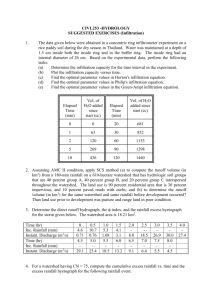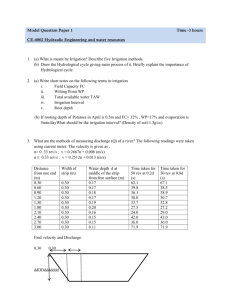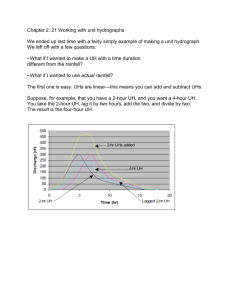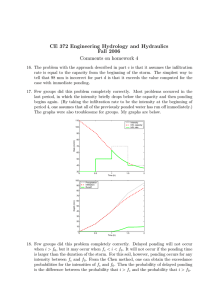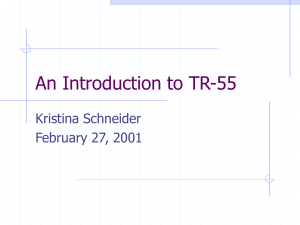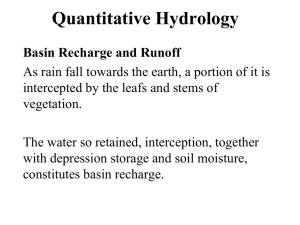cven4333-may06-finals - Civil, Environmental and Architectural
advertisement
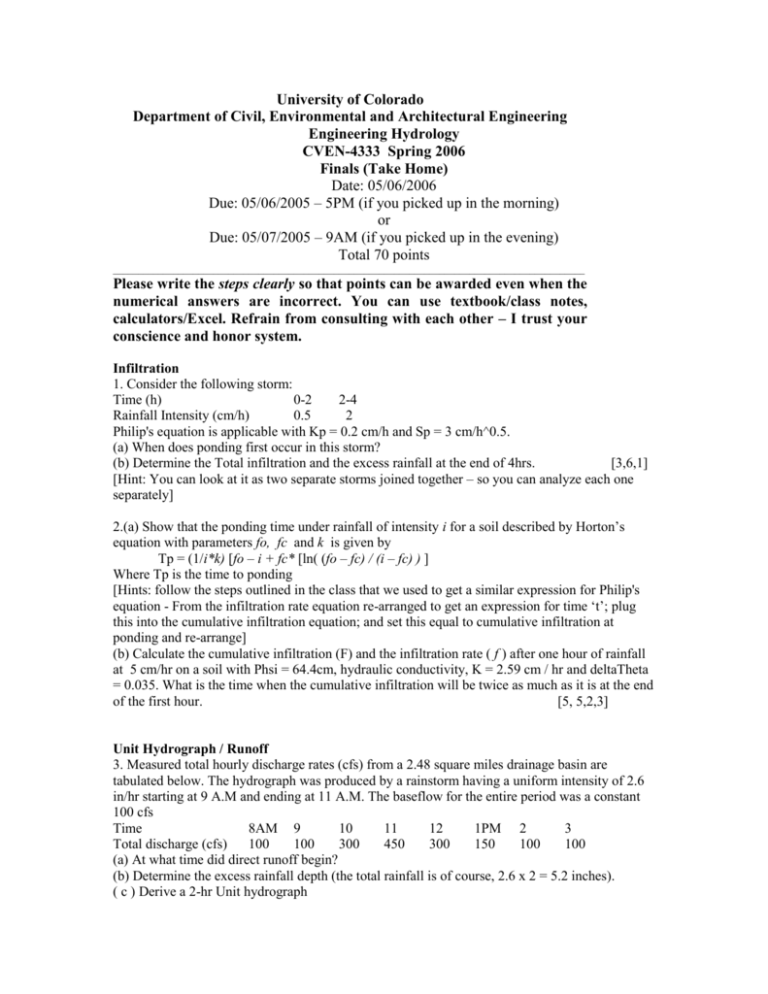
University of Colorado Department of Civil, Environmental and Architectural Engineering Engineering Hydrology CVEN-4333 Spring 2006 Finals (Take Home) Date: 05/06/2006 Due: 05/06/2005 – 5PM (if you picked up in the morning) or Due: 05/07/2005 – 9AM (if you picked up in the evening) Total 70 points ______________________________________________________________________________________________ Please write the steps clearly so that points can be awarded even when the numerical answers are incorrect. You can use textbook/class notes, calculators/Excel. Refrain from consulting with each other – I trust your conscience and honor system. Infiltration 1. Consider the following storm: Time (h) 0-2 2-4 Rainfall Intensity (cm/h) 0.5 2 Philip's equation is applicable with Kp = 0.2 cm/h and Sp = 3 cm/h^0.5. (a) When does ponding first occur in this storm? (b) Determine the Total infiltration and the excess rainfall at the end of 4hrs. [3,6,1] [Hint: You can look at it as two separate storms joined together – so you can analyze each one separately] 2.(a) Show that the ponding time under rainfall of intensity i for a soil described by Horton’s equation with parameters fo, fc and k is given by Tp = (1/i*k) [fo – i + fc* [ln( (fo – fc) / (i – fc) ) ] Where Tp is the time to ponding [Hints: follow the steps outlined in the class that we used to get a similar expression for Philip's equation - From the infiltration rate equation re-arranged to get an expression for time ‘t’; plug this into the cumulative infiltration equation; and set this equal to cumulative infiltration at ponding and re-arrange] (b) Calculate the cumulative infiltration (F) and the infiltration rate ( f ) after one hour of rainfall at 5 cm/hr on a soil with Phsi = 64.4cm, hydraulic conductivity, K = 2.59 cm / hr and deltaTheta = 0.035. What is the time when the cumulative infiltration will be twice as much as it is at the end of the first hour. [5, 5,2,3] Unit Hydrograph / Runoff 3. Measured total hourly discharge rates (cfs) from a 2.48 square miles drainage basin are tabulated below. The hydrograph was produced by a rainstorm having a uniform intensity of 2.6 in/hr starting at 9 A.M and ending at 11 A.M. The baseflow for the entire period was a constant 100 cfs Time 8AM 9 10 11 12 1PM 2 3 Total discharge (cfs) 100 100 300 450 300 150 100 100 (a) At what time did direct runoff begin? (b) Determine the excess rainfall depth (the total rainfall is of course, 2.6 x 2 = 5.2 inches). ( c ) Derive a 2-hr Unit hydrograph [1, 5, 4] 4. You are in-charge of delineating the flood plain for the South Boulder Creek. To do this you have to estimate the peak discharge corresponding to a 100-year 1-hour design storm, which will be passed through a flood plain model for delineation. The peak discharge is obtained from the outflow hydrograph – which in turn is obtained by convoluting the excess rainfall with the unit hydrograph. The following information is provided: (i) The 100-year design rainfall for 1-hour duration is 3.0 inches (ii) The area of the watershed is 132 square miles (iii) The time of concentration (Tc) for this watershed is 1.5 hours (iv) Assume antecedent moisture condition to be wet (i.e. AMC III). The SCS curve number for normal antecedent moisture condition (AMC II) is 84. You have to obtain (a) Excess Rainfall (b) the Unit Hydrograh and ( c ) the peak discharge by convolution [5, 4, 6] Course Synthesis 6. You are now the team leader to design a reservoir in the Pacific Northwest. Assume that you have access to monthly flow data at a nearby gauge on the river and no other data. Having been exposed to a wide ranging aspects of the hydrologic cycle and large-scale climate in the Hydrology course – outline the steps in your design process. [5]


